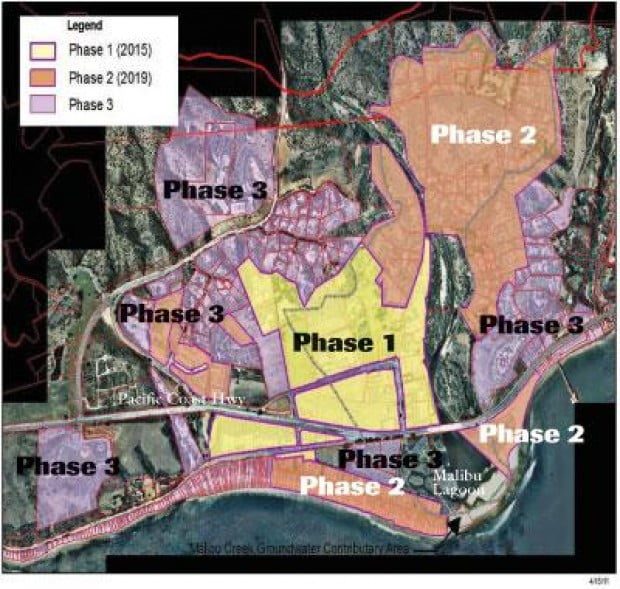
In response to confusion amongst some in the community, The Malibu Times broke down specifics of what properties will be affected by the recent agreement by the city to build centralized wastewater facilities in Malibu.
By Knowles Adkisson / The Malibu Times
Two weeks ago, the Malibu City Council approved a tentative Memorandum of Understanding (MOU) with the Los Angeles Regional Water Quality Control Board to build several centralized wastewater treatment facilities in the Civic Center area. The water board is expected to add its approval to the agreement this Thursday morning at its meeting in Glendale.
The MOU stipulates a three-phase plan in which wastewater treatment facilities will be built by the years 2015, 2019 and possibly 2025. The first phase requires commercial properties in the Civic Center area to hook up to a centralized treatment facility by November 2015. The facility is projected to cost between $32 million and $52 million. According to city officials, the commercial property owners in Phase 1 have agreed to fund the project through an assessment district.
Phase 1 will include such commercial properties as the Malibu Country Mart and Malibu Village (formerly called the Cross Creek center) and other major commercial developments in the Civic Center area, as well as the Malibu Colony Plaza shopping center, which was left out of the regional water board’s original plan. The Malibu Lumberyard is also included in the plans, although the owners built their own wastewater treatment facility, for which the regional board issued a permit, at a cost of $3 million.
Phases 2 and 3 will include residential and other commercial properties.
Estimated costs to the owners of properties in Phases 2 and 3 are between $400 and $500 per month. City staff had also previously estimated that 45 business parcels would have to pay between $6,800 and $17,000 per month to help finance a wastewater treatment facility capable of treating 600,000 gallons per day.
Some residents in the community have expressed confusion about the outlines of Phases 2 and 3, and what it means for their properties. To clear up the confusion, The Malibu Times contacted the City of Malibu to clarify some of the frequently asked questions regarding the agreement. We’ve addressed the questions below.
Which properties are included in Phase 2?
Phase 2 requires a number of residential areas, primarily Serra Canyon, Malibu Colony and condo complexes along Civic Center Way, to hook up to a centralized facility by November 2019. It also includes the Adamson House, Surfrider Beach restrooms, the Malibu Racquet Club and Webster Elementary School. An assessment district would also pay for this wastewater treatment facility. Phase 2 includes all of Malibu Colony, stretching from 23314 Malibu Colony Dr. to 23736 Malibu Colony Dr.
Phase 2 also includes a number of properties east of Malibu Creek. Starting with the Adamson House and ending at Malibu Pier, each of the properties on the seaward side of Pacific Coast Highway is included in Phase 2. Of the residential properties included in that group, the easternmost is 23306 Pacific Coast Highway and the westernmost is 23038 Pacific Coast Highway.
Every residence in Serra Canyon is included in Phase 2. The residents on the other side of the canyon on Sweetwater Mesa are in Phase 3.
Which properties are included in Phase 3, and will the centralized wastewater treatment facility actually be built?
Phase 3 encompasses properties along Malibu Road, the Knolls residential area, HRL Laboratories, Our Lady of Malibu Church and School and Malibu Presbyterian Church. It also includes the residential properties in the Sweetwater Mesa area east of Serra Canyon, as well as commercial properties on Pacific Coast Highway, such as Jack in the Box, Malibu Beach Inn and Malibu Inn up to Sweetwater Canyon Road.
However, construction of a treatment facility for those areas is contingent on water quality studies to be performed after the construction of the treatment facilities in Phases 1 and 2. If water quality in Malibu Lagoon and Surfrider Beach has not improved after the construction of the Phase 1 and 2 treatment facilities, the Phase 3 treatment facility will not be built. However, should water quality improve as a result of the centralized treatment facilities, construction on the Phase 3 facility will proceed as planned.
Will property owners be forced to pay the assessment against their will?
No. The assessment districts will be put up for a vote. If a majority of property owners vote against it, the city then will have to explore other funding avenues, such as a bond measure.
Is the MOU set in stone?
Since it is not a legal settlement, changes can be negotiated by the city or the regional water board.
